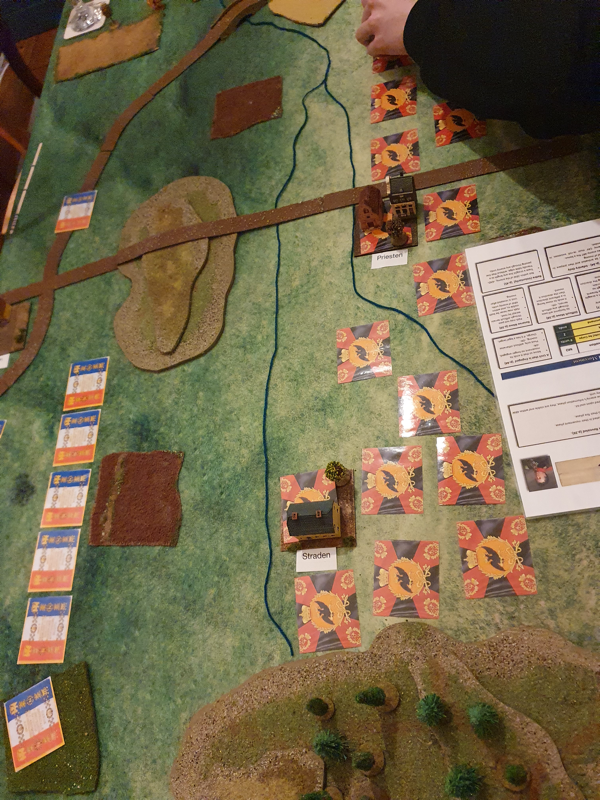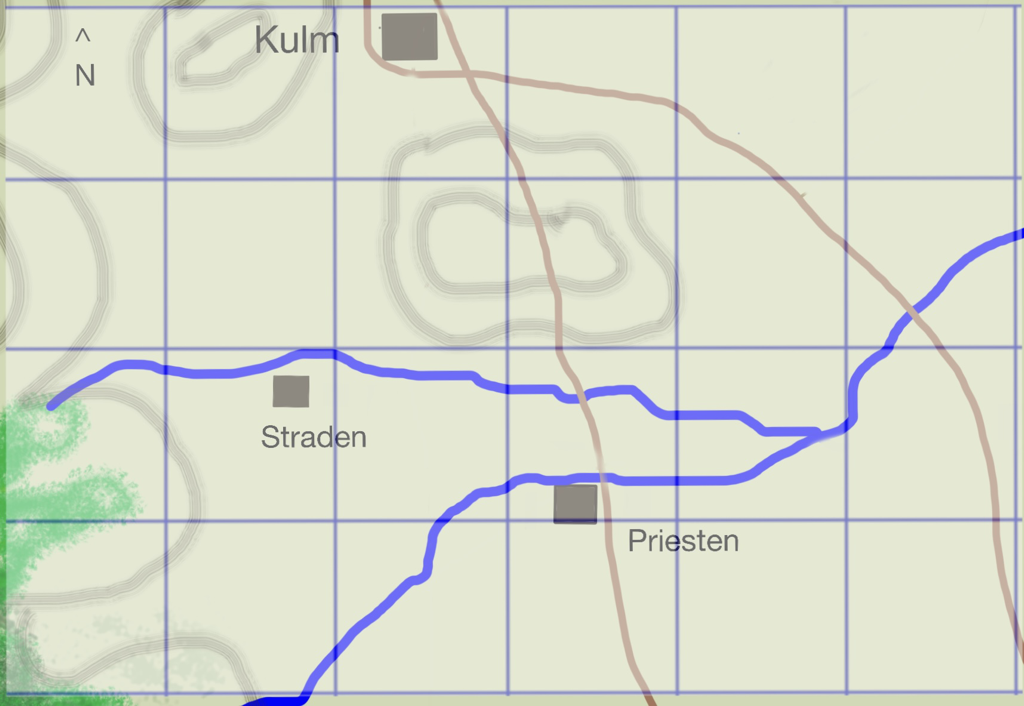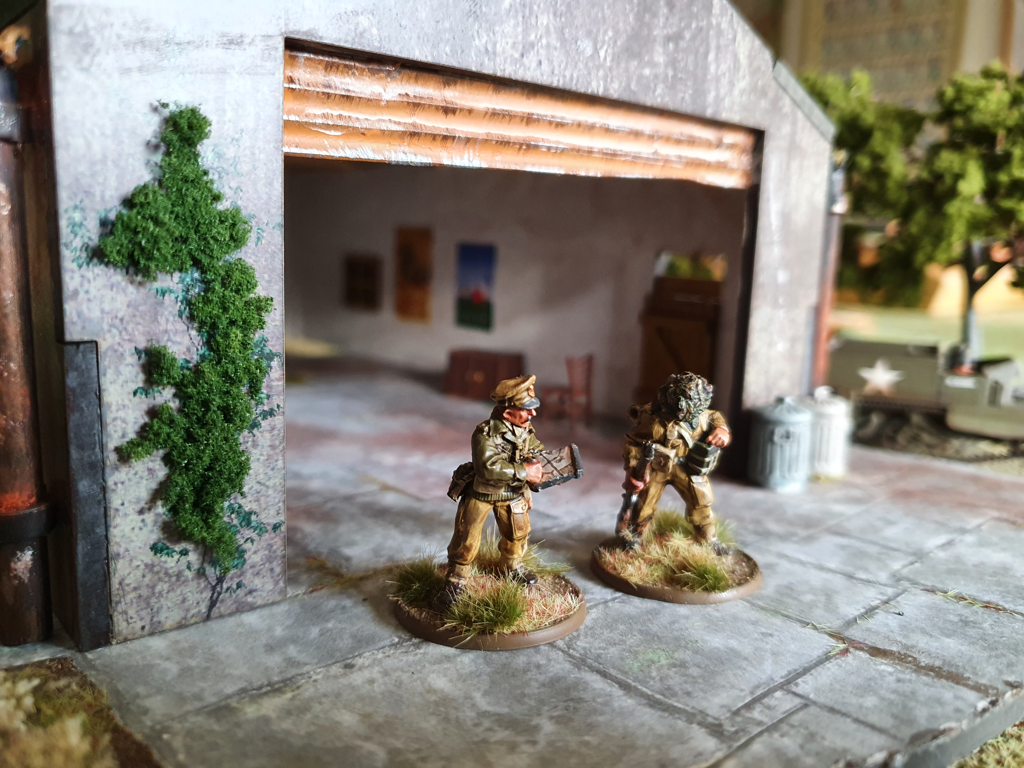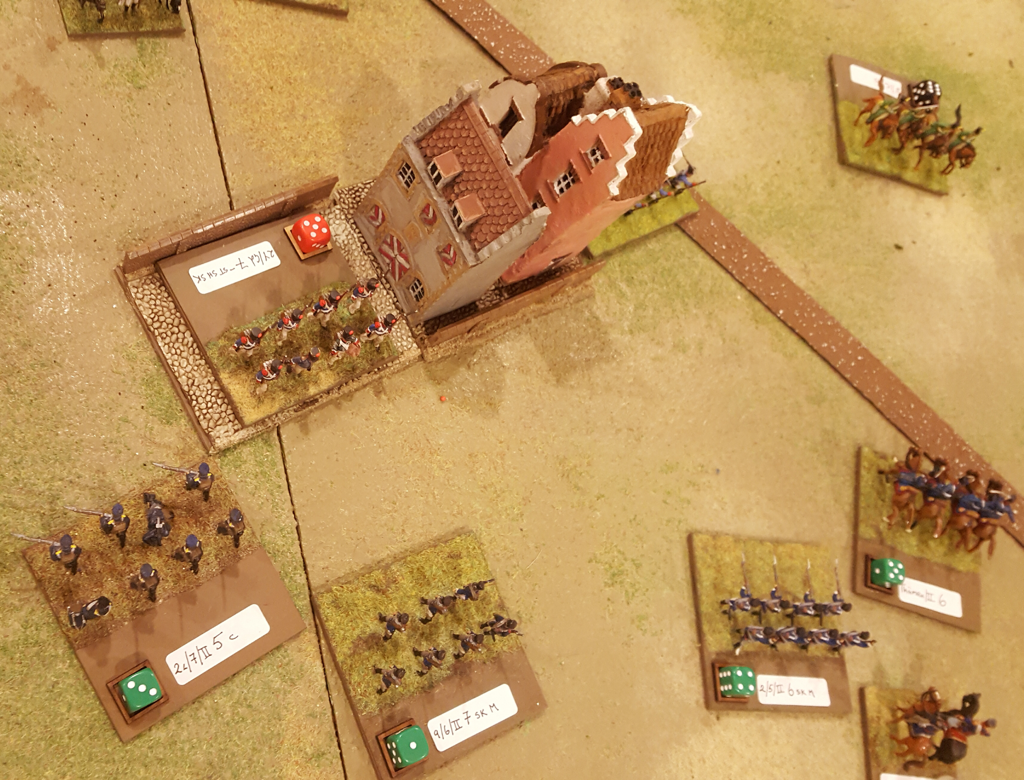|
Matt and I played an impromptu game of Blücher last Wednesday, having established that this really would be our last chance for a wargame before he moves away. I already had units based and labelled for the Waterloo campaign, so we played a game loosely based on the first Prussian attack against Plancenoit. Matt commanded two brigades of the Prussian IV Corps plus Corps cavalry, while I had the French VI Corps, plus Domon and Subervie’s cavalry brigades. Matt’s IV Corps artillery and the French Young Guard would enter as reinforcements. We had two MO dice each. The terrain was impressionistic but not too far off the real geography. Matt’s Prussians emerged from the Bois de Paris on the Eastern table edge, to find VI Corps deployed on high ground to the north east of Plancenoit. The Lasnes stream bounded the southern table edge. The village of Plancenoit was an objective for both sides and victory would go, either to the side occupying it at game end, or to whichever broke enemy morale first. The village was unoccupied at the start. I realised before the first turn that I had already broken the scenario, as the Blücher reserves rule meant that Matt could bypass VI Corps and walk his whole force into and around Plancenoit on his first turn. He is too canny a player to miss an open goal like that. As we were trying to recreate at least the flavour of the historical encounter, we agreed that Matt should treat the village as notionally occupied by the French, meaning that no unit on reserve movement could approach closer than 4BW away. Matt began the game by advancing on Plancenoit on his left with one brigade while screening my French on the high ground with the other. In response, I shifted some of VI Corps to my right, sending one unit into Plancenoit. This had time to form garrison but would soon be ejected by a combined attack by two Prussian units. Meanwhile Matt tried to cut the village off from the rest of the French force by sending cavalry against my centre. The results there came out about even but I was left with a dent in the line. The French Young Guard then arrived and assaulted Plancenoit, failing to break in on the first attempt but kicking the Prussians out with the second attack. Matt’s IV Corps artillery arrived and I started to pull back my left hand infantry unit, which had started to look shaky due to Prussian gunnery. On reflection this was a mistake as the unit soon found itself caught between enemy infantry and cavalry, with no support within reach. By now the turns were running down and Matt concluded he couldn’t eject the Young Guard with his depleted left wing units. Instead he drew back his left and focussed on reducing my morale before the turns ran out. I would have been wise to move back my own command and play for time, since Plancenoit was firmly mine. All I needed to do was hang on for a couple more turns. However we were both one morale point away from defeat and I thought I might break Matt as well as holding the village. What a glorious victory that would be! Of course it went wrong and Matt broke my morale first. Gamer, Know your limits! So the game ended with Matt victorious. VI Corps was badly battered and the Young Guard held Plancenoit, while the Prussians were stood off from the village, with one brigade nearly used up but the other still in goodish shape. Historically the Prussians would soon be reinforced and retake Plancenoit, only to be ejected again by French Old Guard, before the weight of Prussian numbers, combined with the failure of the Middle Guard to break Wellington’s centre, would oblige the French to give up the village for good and join the general retreat.
This was an exciting and absorbing fight, despite its last minute arrangement and the small number of units. Rarely for me, I still haven’t felt the temptation to fiddle with the rules, as they continue to give plausible outcomes and to be great fun to play. With time for preparation I would have checked the map more carefully and given the scenario a dry run, which would have highlighted the risk that the reserves rule could be used to change the nature of the encounter. I could address this by changing French deployment to allow them to occupy Plancenoit at the start, even though this wasn’t actually how VI Corps initially deployed. Alternatively, we could decide that the Prussians cannot take a reserve move because they have been force marching all day from Wavre. The figures we used are a mix of 1/72 scale plastics, which I have collected over many years to create the whole 1815 order of battle, originally based for Volley & Bayonet and Grande Armée. The number of figures per base is a bit sparse but I started this project on a budget. For games set in other campaigns besides 1815, I do prefer 6 or 15/18mm. All in all, our impromptu game was great fun and I’m glad we were able to fit it in.
1 Comment
21/12/2019 12:11:38 pm
I'm interested in smaller games of Blucher - will definitely read back to see how other examples played.
Reply
Leave a Reply. |
Archives
November 2023
Categories
All
|




 RSS Feed
RSS Feed